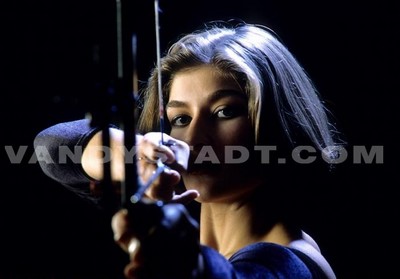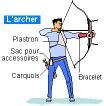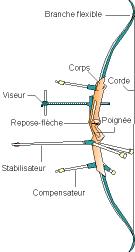| Happy Birthday : |

Archery - Olympic Sports
![]()

The archery dates back to the stone age or 20 000 years BC, C.La first civilization known for its use of the bow and arrow is the Egyptian people, who adopted it are about 5 000 years to hunt and make war.

Hunting weapon around the world since prehistoric weapon of war then in 3 years 000 BC to the Renaissance.
In 1200 BC the Hittites were using the bow from the fast and light trucks, allowing them to terrorize their opponents in battles in the Middle East. Their neighbors, the Assyrians arcs manufactured with different materials: bone, tendon or wood. They also gave the bow a new shape, more curved and more powerful than the bow was shorter and that the archer could easily take over when he was in the saddle. The ancestral rites of chivalry, the archers continued to transmit from generation to generation, provide a unique aesthetic to the revival of Companies, and Family Round. The weapon of fire appeared in the Thirty Years War (1618-1648) ending the use of archery as a weapon of war. It has gradually developed into a weapon of pleasure. The archery takes a sporty orientation is confirmed early in the twentieth century.
The Archers Companies are structured and organized, first in Isle of France, then in northern France and I'ensemble the country to give birth in 1928 to
French Federation of Archery (FFTA) which itself will be at the initiative of creating the Federation Internationale de Tir à RCAF (FITA) Low in 1931 in Poland.The International Federation of Archery has 133 member countries.
In France, there are 52 000 licensed cons 8 000 1972: 42 148 English archers on target with 37 413 in recurve and 4 735 in compound bow.
Key Dates1583: The year of the first official competition of archery at Finsbury in England with the participation of some 3 000 archers.
1931: First WorldChampionship, the event was mixed (Olympic bow)
1991: First World Championship Indoor (Olympic bow)
The archery and OlympismThe archery was an Olympic sport several times between 1900 and 1920 before disappearing from the Games for over 50 years. He made his permanent return to the Munich Games in 1972 with the sacred American John Williams in men and Doreen Wilber women. The archery has one race on the Olympic program: the shooting of 70 m arc classique.La team competition was added to the program of the Seoul Games in 1988. The duel in the final stages was introduced in 1992. In 2004, the 64 archers selected clashed, in
iduellement or in teams of three, when duels knockout. The winners of the semi-finals then meet in the final for the gold and silver, and the losers compete for the bronze medal.

Place arrows at a target distance. Each discipline has its own regulations, both on the principle of running the tests, shooting distances, the shape of fire, as the use of equipment. In all cases, competitions are to accumulate the number of points obtained according to the value impacts of arrows.
Olympic Shooting or classicalIt is the discipline of archery practiced the most in the world. The test consists of 144 arrows shot over 2 days in each of the following distances: 90, 70, 50 and 30 yards, then fire round: Team 3 archers. 12 teams in 1 / 2 final 8 in the final duels at 70 m.
Equipment archers - Arc
A bow of any type may be used provided it meets the principles and ideas that one has a bow used for target shooting, that is to say, an instrument consisting of a handle, a body and two flexible branches each ending in a mouthpiece with a throat.
The arches are made of metal, maple wood or fiberglass or carbon graphite. The length is 1.57 m to 1, 82 m. The weight is 2 to 3.6 kilograms.
The arc is bandaged by a single string attached directly and only to the two ends and use, is held by one hand to the handle while the fingers of one hand, draw, hold and let go of the rope. Other accessories
ers can be used: based arrows mark the viewfinder or on the ground or on the bow, stabilizers, shock absorbers, finger protector, armband, shirt front, strap, quiver.
The arches weigh about 22 kg in the men's competition and 15 kg in the women's competitions.

- Arrows
The arrows on each archer will be marked with the name of the archer, with his initials or his badge. All arrows used for the same score of 3 or 6 arrows will be the same color for the tail and the decoration, if any a.Diamètre maximum of 9.3 millimeters. The arrows are aluminum or carbon fiber for a flight faster.

Good to know: the speed of an arrow in archery can reach over 240 km per hour?
- TargetIt is made of cardboard or straw with a diameter of 1.22 m. The center is located 1.3 miles meters above the ground.
There are ten concentric circles, namely: 2 white (which are 1 and 2 pts), 2 Black (3 and 4 pts), 2 blue (5 and 6 pts), 2 red (7 and 8 pts), 2 golds (9 and 10 pts).

The center of the target, called "gold", measures 12.2 centimeters in diameter. This area is worth 10 points. The value of other circles, point by point decreases gradually as they approach the edge of the target. The outer circle him, not worth one point.
Did you know that the target
Iseo in 10 concentric circles, measuring 1m in diameter 22. For the archer located 70 meters, it is not bigger than a thumbtack held at arm's length?
The competition takes place as follows:
- A qualifying phase on 2 days: open to all participants involved with only the top 24 scores for men and women and the best 12 teams are selected (best 3 scores in
iduels each team). The archers shoot 36 arrows per distance (90-70-50-30 m), or 144 arrows.
- A final stage on 2 days: the top 8 compete until the final two by two in alternate shot. In 40 seconds, the archer must draw 4 ends of 3 arrows (a total of 12 arrows) at a distance of 70 m. The maximum score is 120. If the two archers were tied, there will dam. The archer who shot closest to the center will be declared the winner in the event of a tie in the third. In qualifying, men take to 30 m, 50 m, 70 m and 90 m, and women at 30 m, 50 m, 60 m and 70 m with 36 arrows. Playoff, archers shoot 18 arrows (up 3 flights of 6) at 70 m. The shooting time: 4 minutes for each round.
- Team: Only the top 16 teams of 3 archers competing in the quarterfinals. The 4 best compete until the final two by two.

If the arrow reaches two colors (or line separating 2 areas), the highest point is awarded to the archer.
If the arrow is fixed on another arrow, the archer reaches the same point as the arrow.
If the arrow passes through the target or bounces off another arrow, the archer wins points only if the marks on the target (or arrow) are known.
Other disciplines Shooting in the FieldThe shooting campaign aimed at all those who want to combine the practice of archery in the discovery of nature. The archers move on course with 14 targets whose distances are "known" and 14 others, whose distances are "unknown". Are allowed: all types of bows. The sighting devices are prohibited. Both courses are separate. 4 arrows are fired at each target are 112 in total.
The shooting takes place outdoors on the ground in undergrowth or discovered, rather uneven. Depending on the conformation of the land, the total distance traveled by an archer can range from 1 to several kilometers. On average 2 to 3 km to 12 targets. No regulation does not define the length of a term.
Indoor ShootingPracticed since 1972, mainly in winter, in a gymnasium or hall closed. The shooting took place about 2 times and 30 arrows to select the host, to 25 m or 18 m by 3 flights of arrows. The targets are identical to those of FLTA but 60 cm in diameter for shooting at 25 m and 40 cm for firing at 18 m. The final stages have been introduced in major appointment.
Shooting HuntingIt is not real hunting bow. The fire fighter is a form of sports archery on animal coats, with domestic regulations in our country. The central part of the animal is called "zone killed" and the outer zone wounded. It is usually contested on a course of 21 mounds (42 championships in France). Each archer shoots 2 arrows at each target.
Beursault
Dating from the Middle Ages, is the oldest discipline practiced in France and especially in the north-east of Paris in "The Country of arc" (Oise Aisne Somme). The shooting took place in a specially constructed called "play bow" at a distance of 50 m, on targets of 45 cm in diameter
ized in 3 areas. Two targets facing each other and each archer pulls back and forth a total of 40 arrows. The ranking is the number of arrows into targets (honors), items used to tie the tie.
Archery GolfThis discipline is in competition two different sports in their technique, but similar in their objective: precision shooting. Archers and golfers compete on a golf course. They should approach the "green" in a minimum of shots: one with his bow and arrow, the other with his club and his ball. On the "green" I'archer dropped a 15 cm ball balanced on a tripod, a golfer sends his ball in a hole the same size.
Glossary
Archer archer.
Backgrounds: Part of the handle of the bow that faces the target when the archer draws.
Blind shelter where the judges are scoring, the representatives of archers and an observer.
Bander (bow): Pull the string and the arrow backwards to prepare a shot.
Blason: Paper on the target, with brand value,
ized into five zones colored (yellow, red, blue, black and white), themselves divided into two zones of equal width.
Strap: leather accessories, plastic or wood which protects the arm of the arc.
Branch: top or bottom of an arc from the handle to the tip.
Butte: An object which is fixed on the shield.
Quiver: case in which the arrows are arranged.
Cord: an arrow is called "cordon" when it is in the border areas between two points.
Strap: accessory connecting arc fingers.
Punching: Put an arrow on a bowstring.
Flank: Part of the handle of the bow facing the archer when pulled.
Shaft: Long stick or rod forming the body of the arrow.
Group: 1. Pattern formed by the arrows on the target. 2. (Make a) Draw three arrows at a target.
Waiting line: Line located five meters behind the hold line, where the archers who are not in competition can be held.
Line of Fire: Line on which stands the shooter.
Archers Lodge: Area located one meter behind the line of fire when the archers of the team event waiting their turn.
Main carrier: hand holding the bow, usually the left hand.
Channel: Stage a competition in which an archer trying to move from one stage to the next.
Brands: Any arrow that hit the target and applies a number of points.
Game: Duel in between two
idus or two teams.
Mile: focal point on the target.
Observer: A person who identifies each score of archers with a telescope and took the score.
Route simple: a simple route includes 12 ends of 3 arrows.
Full itinerary: two simple term, the first unknown distances, the second to distances known.
Breastplate: piece of leather to protect the chest, or used clothing in case of too loose.
Tip: End of a sharp arrow.
Recurve: bend, bend or curl. Named after the shape of the legs of the arch "recurve".
Robin Hood (Robin Hood): Action to separate the two was an arrow already on the target with another arrow.
Stabilizers: rods and weights of different lengths, caused by the archer, which absorb vibration or delay for the release of string.
Shooting: Distance at which an arc sends an arrow.
Flock: A group of arrows, usually three, shot in one sequence before the guard did not remove them from the target.
X: Make an arrow which hit the central circle, or X10, in the mile of a target.
Copyright Sportquick/Promedi




(9).jpg)
.jpg)







